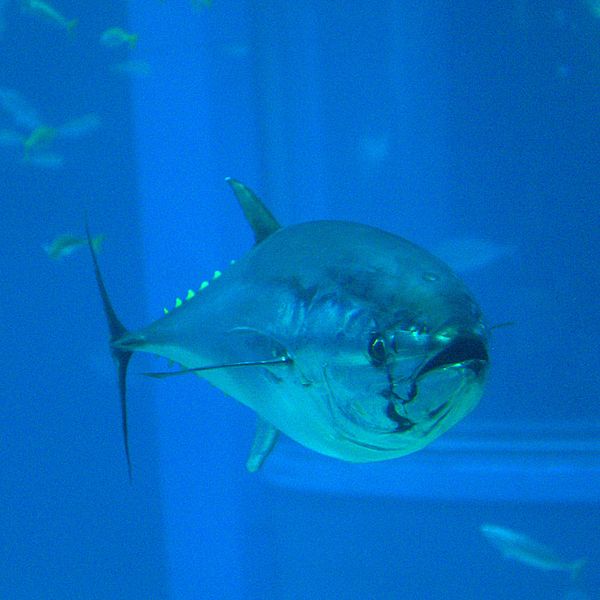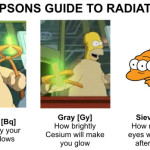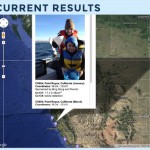
There’s nothing like a terrifying headline to point out how differently scientists and the public see the world. On Monday, a new study in the Proceedings of the National Academy of Sciences of the United States (PNAS) found that Pacific bluefin tuna had carried detectable radiation from the Fukushima meltdown across the Pacific, and the headline freakouts began. As NPR reporter Richard Harris* pointed out, “What snarky headline writer could resist a story about ‘hot tuna?’ Or how about ‘tuna meltdown?'”
The mere mention of radiation terrifies people – and certainly the Fukushima meltdown was scary. But there’s a big difference between DETECTABLE radiation and HAZARDOUS radiation. The ocean is absolutely filled with detectable radiation, mostly from naturally occurring compounds like potassium-40. There’s human-introduced radiation too – in fact, traces from nuclear testing in the 1950s and 1960s is used to estimate when deep ocean water last “breathed” at the surface. This doesn’t mean that a watery version of Chernobyl lurks in the deep, just that radioactive materials are sometimes so rare in the world that tiny quantities can be linked to specific happenings.
The same thing is happening with the Fukushima fallout, at least in the ocean (I can’t speak to radiation on land). Fukushima did increase cesium (Cs) isotopes in waters off Japan by 10–1,000 times, but that’s because previous levels were very, very low. So this increase is DETECTABLE but not HAZARDOUS. (Have you started to notice a theme here?) Same thing for the radiation found in zooplankton and marine fishes in June 2011. From another PNAS study by Buessler et al. released this April:
Concentration factors—essentially the degree of radionuclide enrichment in biota relative to ambient water—are used to evaluate the radiological risks associated with seafood consumption and were determined by dividing the radionuclide concentration in biota by the dissolved concentration in surface water. Median values were 44 for 137 Cs and 36 for 134 Cs, comparable to the recommended International Atomic Energy Agency (IAEA) value of 40 for zooplankton….The median concentration of 137 Cs in micronektonic fish (secondary consumers) was less than that in zooplankton (primary and secondary consumers) and about 150-fold below the Japanese legal limit for fish of 500 Bq·kg−1 wet weight.
So teeny fish in the waters off Japan just a few months after Fukushima had such low levels of radioactivity that they are considered safe to eat under Japanese law. And of this radioactivity, only 10-30% of the total radioactivity found in marine life was attributable to the Fukushima discharges – the rest was from naturally occurring radionuclides, mostly potassium-40.
So this brings us to the new study by Madigan et al. on big fish that used to be in the waters off Japan, but went and swam over to California – the Pacific bluefin tuna. This study examined 15 juvenile bluefin that were spawned in Japan and caught off San Diego, California. Again, the researchers found a DETECTABLE increase – the bluefin tuna caught in 2011 had total 134+137 Cs concentrations about 10 times higher than bluefin tuna caught in previous years. But was it HAZARDOUS?
The tuna contained 134 Cs at 4.0 ± 1.4 Bq per kg and 137 Cs at 6.3 ± 1.5 Bq per kg. (Here’s an explanation of the Becquerel (Bq), which is the unit of radioactivity.) In contrast, the FAO limit for both cesium radionuclides in human food (including infant food) is 1,000 Bq per kg. The United States FDA limit is 1,200 Bq per kg. Japan’s limit used to be 500 Bq per kg, but they just lowered it to 100 Bq per kg – but the tuna caught off California contains ten times LESS radiation than even the strictest food limit. What’s the theme? DETECTABLE but not HAZARDOUS. As Richard Harris put it:
Really, the result is a testament to how well scientists can now measure tiny amounts of radiation. And of course it’s a remarkable lesson in how wildlife can be traced using accidental “tags” instead of using the labor-intensive plastic ones.
If you are still worried about the cesium from Fukushima, Robert Emery at the University of Texas Health Science Center at Houston says you’d need to eat 2.5 to 4 tons of tuna in a year to get a dose of cesium-137 that exceeds health limits. That’s a lot of sushi.
Now, there are lots of reasons to decline to eat bluefin tuna, which I’ve written about extensively. (Also see Eric Heupel’s great comment on the cost of ranching Pacific bluefin). But really what this story shows is that bluefin are amazing fish that travel vast distances before they’re even grown up! It’s a story about cool science, and there’s no need for it to be muddied by fear.
*Full disclosure: Holly and I (along with Andrew Thaler) met Richard Harris at the 2012 Ocean Sciences Meeting and lured him into drinking some beers with us. Many squeees were squeeed. Probably this is more of a fun story than a necessary disclosure. Oh, well.
References:
Buesseler, K. O., S. R. Jayne, N. S. Fisher, I. I. Rypina, H. Baumann, Z. Baumann, C. F. Breier, E. M. Douglass, J. George, A. M. Macdonald, H. Miyamoto, J. Nishikawa, S. M. Pike, and S. Yoshida. 2012. Fukushima-Derived Radionuclides in the Ocean and Biota Off Japan. Proceedings of the National Academy of Sciences 109:5984–5988. doi: 10.1073/pnas.1120794109.
Madigan, D.J., Bauman Z. and Fisher N.S. Pacific bluefin tuna transport Fukushima-derived radionuclides from Japan to California. Proceedings of the National Academy of Sciences. Published online before print May 29, 2012, doi:10.1073/pnas.1204859109.






They should carefully operate a good radioactive transport for these creatures. It is so sad that they were affected by the radiation. I wonder what can the scientists do to help these creatures.
They just talk about the Bluefin but what about the Albacore they also migrate through Japans waters.
Doesn’t it bioaccumulate? Is this not like saying a few drops of draino a day isn’t bad for you?
Your article is misleading, dangerous to humanity, and quite alarming . Obviously you do not have a clue about the ongoing disaster at Daiichi Fukushima. Go to school, learn about radiation and its effects, amd then when you are knowledgeable about the subject matter, file your story, until then stop lying to people.
Travis,
Please actually read the article above. The article dates back to last year. At that time, two independent studies confirmed that radioactivity in fish although detectable was far below hazardous levels. There is absolutely nothing misleading about this. The data show what the data show. Period. What is more dangerous is continuously crying wolf and spreading disinformation, especially when people’s livelihoods are tied to seafood.
As chief editor of DSN, I can certify that all of my writers are research scientists, experts in the fields, with years of experience in their specialities. Each post here is extremely well researched and delivered by an expert.
BULL..”especially when people’s livelihoods are tied to seafood.” is the key sentence. Tell the truth you and the radiated fish dept are out of a job. Sort of like giving chemo to a patient, they know it will kill but why tell the truth? We would be out of a job..
dont make me come down there……